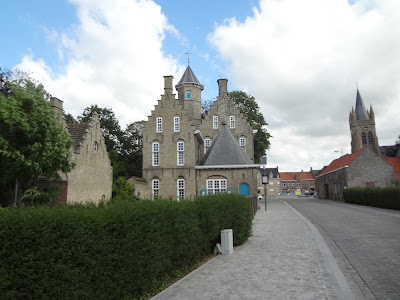Tuesday 9 and Wednesday 10 June 2015
 |
| 14 kilometers, 2 hours 10 minutes |
we up-anchored (figuratively of course) and headed
downstream to Knokkebrug and then south onto the Ieper-IJzer and, after a 180 degree
turn so that we were bow-on to the wind, moored up at a free pontoon just before
the Steenstratebrug (‘Stone Streets Bridge’) and toddled over the road to the
delightful ‘Eetkaffee Steenstraete’ to enjoy a cold beer.
 |
| Steenstratebrug mooring with 'Eetkaffee' in background. |
Later that afternoon we walked the couple of kilometres to the memorial erected in memory of the brothers Van Raemdonk
and Fievez, made out of masonry from the German stronghold ‘Stampkot’. This
memorial has become one of the rallying points of Flemish nationalism.
At the end of the
afternoon on 22 April 1915, the German troops released approximately 150 tons
of chlorine gas at the allies, which were dug in at the Northern side of the
so-called Ieper Salient between Steenstrate and Langemarck. This meant the
start of chemical warfare in World War I, which would only increase up to the
point where near the end of the war in 1918 approximately 25% of all ammunition
would carry a chemical payload.
In 1929 the veteran
French soldiers of the 418th regiment at Steenstrate erected a monument in
commemoration of the first major gas attack with chlorine gas. The memorial was
made by the French artist Maxime Real del Sarte and realistically portrayed a soldier
with his hands around his neck fighting for one last sip air. Two soldiers are
already choked at his feet. The text under the monument read that on April 22,
1915 troops of the French 45th Division and the 87th Territorial Division were
poisoned by gas and since then there were still casualties of this terrible
weapon which was first used by the Germans.
This monument was
clearly a thorn in the foot for the Germans and they blew up the monument
during the Second World War in May 1941. Which says something about the
realistic expressiveness of the memorial. http://www.zilvercruys.be/monument.en.html
Wednesday, after first having to fix a puncture on my
E-bike,
Langemark was a bustling little town with a small morning
market on the go and a Tourist Office without any sign that it was such (“As we
are not open on Saturday afternoons and Sundays we don’t want to mislead people
by putting up a ‘Tourist Office’ sign”!); but the big ‘drawcard’ was the very
sombre, oak tree lined, WWI German cemetery, enclosing the graves of, and memorial
to, some 44,000 soldiers including 3,000 student volunteers, named and unknown,
who died in the area.
 |
| The names of unknown soldiers subsequently identified. |
From there it was on to Poelkapelle
 |
| Striking memorial in Poelkapelle |
with its famous Stork
memorial to the French WWI flying ace, Georges Guynemer, who went missing in
action near the town on 11 September 2017. https://en.wikipedia.org/wiki/Georges_Guynemer
 |
| Delicious! |
Then it was on to Boezinge (almost via Ieper in a vain
attempt to find the Yorkshire Trenches) and Zuidschote in an effort to find
somewhere to have a late lunch but it would seem that all the restaurants close
on Tuesdays and Wednesdays so it was back to the larder on board, and nothing
wrong with that either!










No comments:
Post a Comment